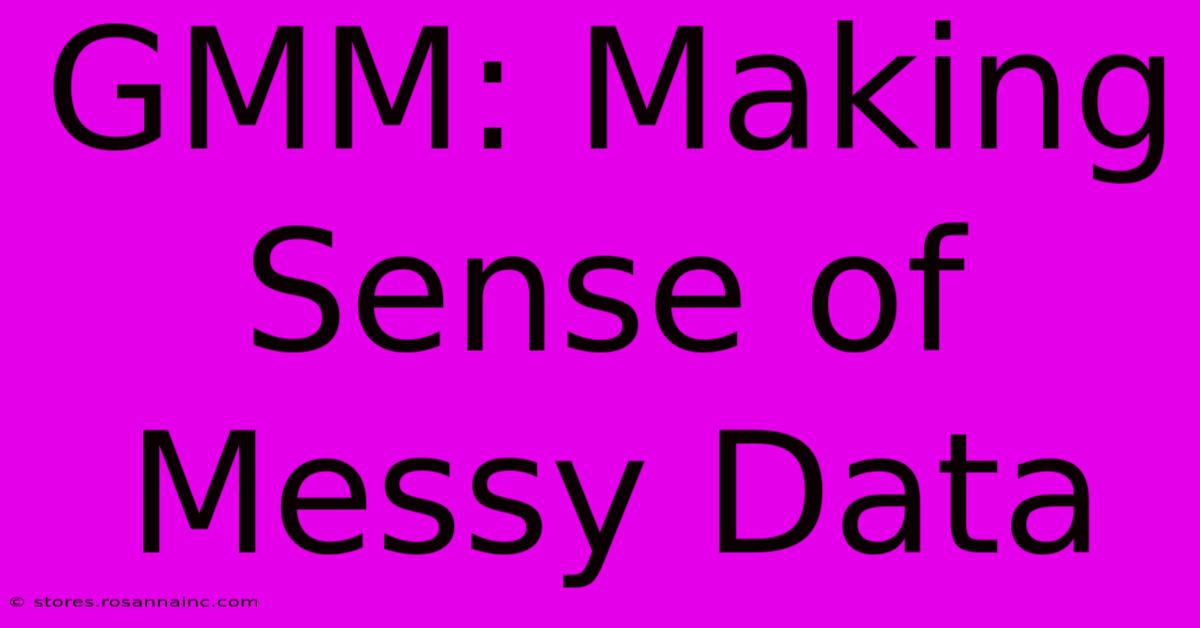GMM: Making Sense Of Messy Data

Table of Contents
GMM: Making Sense of Messy Data
In today's data-driven world, we're often faced with messy, complex datasets. Understanding and extracting meaningful insights from this data is crucial for informed decision-making across various fields, from finance and marketing to healthcare and scientific research. Gaussian Mixture Models (GMMs) offer a powerful and versatile approach to tackling this challenge. This article will explore what GMMs are, how they work, and their applications in making sense of messy data.
What is a Gaussian Mixture Model (GMM)?
A Gaussian Mixture Model (GMM) is a probabilistic model that assumes the data is generated from a mixture of several Gaussian distributions (also known as normal distributions). Each Gaussian distribution represents a distinct cluster or group within the data. Think of it like this: your data might look like a chaotic jumble, but GMM tries to identify underlying patterns by separating it into distinct, bell-shaped curves (the Gaussians). Each curve represents a different sub-population within your overall dataset.
Key Components of a GMM:
- Gaussian Distributions: These are the building blocks of the model. Each Gaussian is defined by its mean (center) and covariance matrix (spread and orientation).
- Mixing Weights: These represent the proportion of data points belonging to each Gaussian distribution. They sum up to 1, reflecting the relative contribution of each cluster to the overall data.
- Parameters: The model's parameters are the means, covariance matrices, and mixing weights of all the Gaussian distributions. These parameters are estimated from the data using algorithms like Expectation-Maximization (EM).
How GMMs Work: The Expectation-Maximization Algorithm
The Expectation-Maximization (EM) algorithm is a powerful iterative method used to estimate the parameters of a GMM. It works in two steps:
1. Expectation (E-step): This step assigns probabilities to each data point, indicating the likelihood of it belonging to each Gaussian distribution. These probabilities are based on the current estimates of the model's parameters.
2. Maximization (M-step): This step updates the model's parameters (means, covariance matrices, and mixing weights) to maximize the likelihood of the observed data given the probabilities assigned in the E-step.
The E-step and M-step are repeated iteratively until the model converges, meaning the parameter estimates no longer change significantly. This iterative process refines the model's representation of the data, leading to better cluster identification.
Applications of GMMs: Unveiling Hidden Structure
GMMs have a wide range of applications across diverse fields:
1. Clustering: GMMs are excellent for clustering data points into distinct groups based on their similarity. This is particularly useful when dealing with datasets that don't have easily defined clusters.
2. Density Estimation: GMMs can be used to estimate the probability density function of a dataset. This allows for understanding the distribution of data points and identifying regions of high and low density.
3. Anomaly Detection: By identifying data points that fall outside the fitted Gaussian distributions, GMMs can effectively detect outliers or anomalies in a dataset.
4. Image Segmentation: GMMs can be employed to segment images into different regions based on pixel characteristics, like color or texture.
5. Financial Modeling: GMMs can model the distribution of financial returns, facilitating risk management and portfolio optimization.
Advantages and Disadvantages of GMMs
Advantages:
- Flexibility: GMMs can model complex data distributions with multiple clusters and varying shapes.
- Probabilistic Framework: Provides a probabilistic interpretation of data clustering, allowing for uncertainty quantification.
- Wide Applicability: Useful across numerous fields and tasks.
Disadvantages:
- Sensitivity to Initialization: The EM algorithm can converge to different solutions depending on the initial parameter estimates.
- Computational Complexity: Can be computationally expensive for very large datasets with many clusters.
- Assumption of Gaussianity: The model assumes that data within each cluster follows a Gaussian distribution, which might not always be true.
Conclusion: Harnessing the Power of GMMs
Gaussian Mixture Models provide a robust and versatile approach to analyzing complex and messy datasets. Their ability to uncover hidden structure, estimate densities, and detect anomalies makes them an indispensable tool for data scientists and researchers across many domains. While challenges like sensitivity to initialization exist, the benefits of using GMMs in revealing valuable insights from seemingly chaotic data significantly outweigh the limitations, making them a valuable asset in the world of data analysis. By understanding their capabilities and limitations, you can effectively leverage GMMs to make sense of even the most challenging datasets.

Thank you for visiting our website wich cover about GMM: Making Sense Of Messy Data. We hope the information provided has been useful to you. Feel free to contact us if you have any questions or need further assistance. See you next time and dont miss to bookmark.
Featured Posts
-
Right Here Waiting The Song That Defined A Generation
Feb 09, 2025
-
Affordable Living In Picturesque New Mexico Towns
Feb 09, 2025
-
Gwynnes Dismissal Bad Judgment
Feb 09, 2025
-
Say Goodbye To Reptile Roommates The Solitary African Fat Tailed Gecko
Feb 09, 2025
-
Grand Island Ne County Your Unexpected Oasis
Feb 09, 2025
